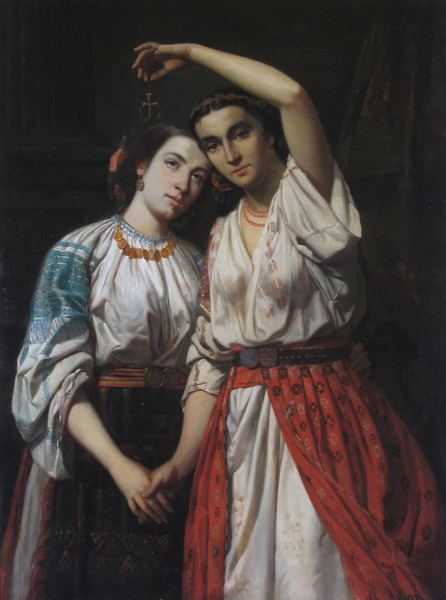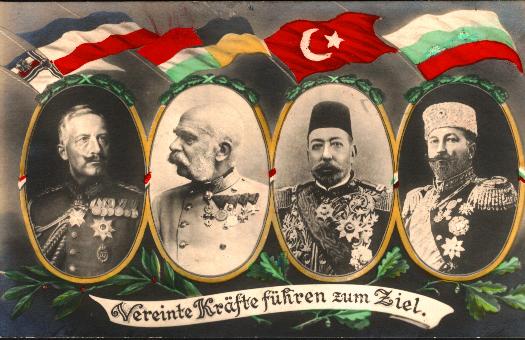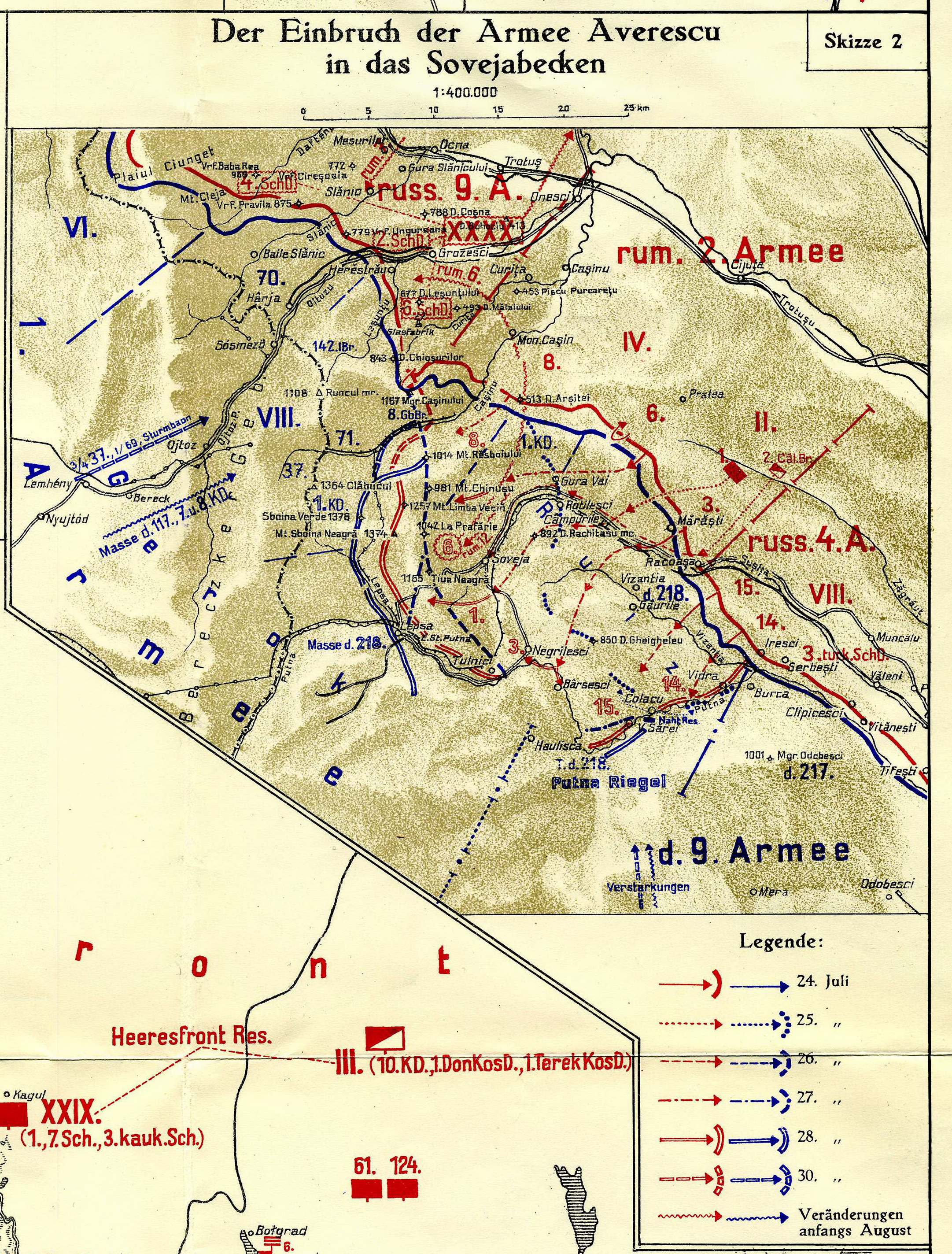|
Romanian Campaign (1917)
The 1917 Romanian Campaign consisted in three battles between late July and early September 1917, fought between Germany and Austria-Hungary on one side versus Romania and Russia on the other. Romania emerged from this campaign with a slight net territorial gain and won its most important battle during the First World War. Background Although largely overrun in the winter of 1916, Romania had managed to remain in the war, holding a territorial rump in Moldavia with assistance from Russian forces. The French military mission in Romania helped rebuild the Romanian Army, as Russia's was disintegrating. The reorganization of the Romanian Army had been completed by June 1917. The 1,500-strong French military mission, headed by General Henri Berthelot, included 300 officers who provided expert instruction in the use of new weapons and tactics, particularly the conduct of a war of position. The Romanian Army at the end of the reorganization stood at 460,000 strong (not including irregul ... [...More Info...] [...Related Items...] OR: [Wikipedia] [Google] [Baidu] |
Romania During World War I
The Kingdom of Romania was neutral for the first two years of World War I, entering on the side of the Allied powers from 27 August 1916 until Central Power occupation led to the Treaty of Bucharest in May 1918, before reentering the war on 10 November 1918. It had the most significant oil fields in Europe, and Germany eagerly bought its petroleum, as well as food exports. From the point of view of its belligerent status, Romania was a neutral country between 28 July 1914 and 27 August 1916, a belligerent country on the part of the Entente from 27 August 1916 to 9 December 1917, in a state of armistice with the Central Powers from 10 December 1917 to 7 May 1918, a non-combatant country between 7 May 1918 and 10 November 1918, and finally a belligerent country in the Entente between 10 and 11 November 1918. At the start of World War I, King Carol I of Romania favored Germany, while the nation's political elite favored the Entente. As such, the crown council took the decision to ... [...More Info...] [...Related Items...] OR: [Wikipedia] [Google] [Baidu] |
German Empire
The German Empire (),Herbert Tuttle wrote in September 1881 that the term "Reich" does not literally connote an empire as has been commonly assumed by English-speaking people. The term literally denotes an empire – particularly a hereditary empire led by an emperor, although has been used in German to denote the Roman Empire because it had a weak hereditary tradition. In the case of the German Empire, the official name was , which is properly translated as "German Empire" because the official position of head of state in the constitution of the German Empire was officially a "presidency" of a confederation of German states led by the King of Prussia who would assume "the title of German Emperor" as referring to the German people, but was not emperor of Germany as in an emperor of a state. –The German Empire" ''Harper's New Monthly Magazine''. vol. 63, issue 376, pp. 591–603; here p. 593. also referred to as Imperial Germany, the Second Reich, as well as simply Germany, ... [...More Info...] [...Related Items...] OR: [Wikipedia] [Google] [Baidu] |
Panciu
Panciu () is a town in Vrancea County, Romania. It lies on the river Șușița, in the southern part of Western Moldavia, northwest of Focșani. It has a population of approximately 7,600. It administers five villages: Crucea de Jos, Crucea de Sus, Dumbrava, Neicu and Satu Nou. The town is located in the east-central part of the county, on the banks of the Șușița River. The region is famous for its white wines but also for its sparkling wines (white, red and rosé). Writer Ioan Slavici died in Panciu in 1926, and was buried at the hermitage within . Natives * Stelian Isac * Dan Nica Dan Nica (born July 2, 1960) is a Romanian engineer and politician. A member of the Social Democratic Party (PSD), he has been a Member of the European Parliament since 2014. He held a seat in the Romanian Chamber of Deputies for Galați County f ... References External links Panciu Town Hall Towns in Romania Populated places in Vrancea County Localities in Western Moldavia { ... [...More Info...] [...Related Items...] OR: [Wikipedia] [Google] [Baidu] |
Focșani
Focșani (; yi, פֿאָקשאַן, Fokshan) is the capital city of Vrancea County in Romania on the banks the river Milcov, in the historical region of Moldavia. It has a population () of 79,315. Geography Focșani lies at the foot of the Curvature Carpathians, at a point of convergence for tectonic geologic faults, which raises the risk of earthquakes in the vicinity. Though Vrancea County is one of the most popular wine-producing regions in Romania, Odobești being just to the northwest, in Romania, Focșani itself is not considered a wine-producing center. The wine sold as ''Weisse von Fokshan'' in Germany and some other European countries is generally a ''Fetească Albă de Odobești'' wine, and practically a second-rated wine which does not comply to the European Union rules of naming the regions of origin of wines. The vicinity is rich in minerals such as iron, copper, coal, and petroleum. The city administers two villages, Mândrești-Moldova and Mândrești-Munteni. ... [...More Info...] [...Related Items...] OR: [Wikipedia] [Google] [Baidu] |
Battle Of Mărășești
The Battle of Mărășești (6 August 1917 – 3 September 1917) was the last major battle between the German Empire and the Kingdom of Romania on the Romanian front during World War I. Romania was mostly occupied by the Central Powers, but the Battle of Mărășești kept the northern region of the country free from occupation. Background Mărășești, just like Mărăști, is part of the strategically important area of the Focșani Gate. Control of this area eases attacks into several Romanian regions. On 22 July 1917, the Romanians launched a joint offensive with Russia against the Austro-Hungarian 1st Army, around Mărăști and the lower part of the Siret river, which resulted in the Battle of Mărăști. Although there was some initial success, a counter-offensive by the Central Powers in Galicia stopped the Romanian-Russian offensive. Battle The Central Powers planned a dual pincer movement attack: an offensive towards Adjud and an offensive towards Oituz. The Bat ... [...More Info...] [...Related Items...] OR: [Wikipedia] [Google] [Baidu] |
Oituz (river)
The Oituz ( hu, Ojtoz) is a right tributary of the river Trotuș in Romania. It discharges into the Trotuș in Onești. e-calauza.ro The following towns and villages are situated along the river Oituz, from source to mouth: Brețcu, Oituz (CV), Poiana Sărată, Oituz, Oituz (BC), Bogdănești, Bacău, Bogdănești and Onești. Its length is and its basin size is . References Rivers of Romania Rivers of Bacău County Rivers of Covasna County {{Bacău-river-stub ...[...More Info...] [...Related Items...] OR: [Wikipedia] [Google] [Baidu] |
Adjud
Adjud (; hu, Egyedhalma) is a municipiu, city in Vrancea County, Western Moldavia, Romania. It has a population of 14,670 inhabitants (2011). It lies at a railway junction which has a classification yard and a passenger station. Adjud, situated north of the point where the river Trotuș enters the Siret (river), Siret, used to be a marketplace. The city administers three villages: Adjudu Vechi, Burcioaia and Șișcani. Geography Adjud is situated on a plain and is surrounded by hills up to a height of 400 meters at the foot of the southern Carpathians. The average altitude of the town is 100 m Above mean sea level, above sea level. The surrounding land is favorable for agriculture. Geological research findings show the city's subsoil having layers of gravel and sand Levantine and Quaternary, forming significant hydrological aquifers deposits fed by the Trotuș and Siret rivers and direct rainfalls. The climate is temperate with annual average temperature of 8- and an averag ... [...More Info...] [...Related Items...] OR: [Wikipedia] [Google] [Baidu] |
Central Powers
The Central Powers, also known as the Central Empires,german: Mittelmächte; hu, Központi hatalmak; tr, İttifak Devletleri / ; bg, Централни сили, translit=Tsentralni sili was one of the two main coalitions that fought in World War I (1914–1918). It consisted of the German Empire, Austria-Hungary, the Ottoman Empire, and the Kingdom of Bulgaria and was also known as the Quadruple Alliance.german: Vierbund, tr, Dörtlü İttifak, hu, Központi hatalmak, bg, Четворен съюз, translit=Chetvoren sūyuz Colonies of these countries also fought on the Central Powers' side such as German New Guinea and German East Africa, until almost all of their colonies were occupied by the Allies. The Central Powers faced and were defeated by the Allied Powers that had formed around the Triple Entente. The Central Powers' origin was the alliance of Germany and Austria-Hungary in 1879. Despite having nominally joined the Triple Alliance before, Italy d ... [...More Info...] [...Related Items...] OR: [Wikipedia] [Google] [Baidu] |
Battle Of Mărăști
The Battle of Mărăști ( ro, Bătălia de la Mărăști) was one of the main battles to take place on Romanian soil in World War I. It was fought between 22 July and 1 August 1917, and was an offensive operation of the Romanian and Russian armies intended to encircle and destroy the German 9th Army. The operation was planned to occur in tandem with the Nămoloasa offensive; however, this operation was abandoned before it began. Background Mărăști, just like Mărășești, is part of the strategically important Focșani Gate, the control of which eases attacks into several Romanian regions. The opposing forces At the beginning of July, based on the campaign plan drawn up in May by the High Command, final instructions were given to the 1st and 2nd Romanian Armies. The 1st Army was to carry out the principal attack around Nămoloasa and then, on terrain prepared by the latter, the 2nd Army, commanded by General Alexandru Averescu, was to carry out a second-order attack towar ... [...More Info...] [...Related Items...] OR: [Wikipedia] [Google] [Baidu] |
Keith Hitchins
Keith Arnold Hitchins (April 2, 1931 – November 1, 2020) was an American historian and a professor of Eastern European history at the University of Illinois at Urbana-Champaign, specializing in Romania and its history. He was born in Schenectady, New York. After graduating from Union College, he went to Harvard University, earning a Ph.D. in history in 1964 under the direction of Robert Lee Wolff. After teaching for seven years at Wake Forest University and then for a short period at Rice University, he joined the faculty at the University of Illinois, where he spent the rest of his academic career. Hitchins wrote or edited more than 20 books, most related to Romania. An honorary member of the Romanian Academy since 1991, he was awarded the National Order of Merit by Romanian President Klaus Iohannis. Hitchins died on November 1, 2020, at age 89, in the Carle Foundation Hospital in Urbana, Illinois. After his death, Romanian Minister of Foreign Affairs Bogdan Aurescu wrote o ... [...More Info...] [...Related Items...] OR: [Wikipedia] [Google] [Baidu] |
Henri Berthelot
Henri Mathias Berthelot (7 December 1861 – 29 January 1931) was a French general during World War I. He held an important staff position under Joseph Joffre, the French commander-in-chief, at the First Battle of the Marne, before later commanding a corps in the front line. In 1917 he helped to rebuild the Romanian Army following its disastrous defeat the previous autumn, then in summer 1918 he commanded French Fifth Army at the Second Battle of the Marne, with some British and Italian troops under his command. In the final days of the war he again returned to Romania, helping fight the Hungarians during the Hungarian–Romanian War and then briefly commanded French intervention forces in southern Russia in the Russian Civil War, fighting the Russian Bolsheviks in Bessarabia (1918). Appointed a member of the ''Conseil supérieur de la guerre'', he was among the supporters of the decision to build the Maginot Line. Biography Early life In 1883, after graduating from the Saint- ... [...More Info...] [...Related Items...] OR: [Wikipedia] [Google] [Baidu] |


.jpg)


